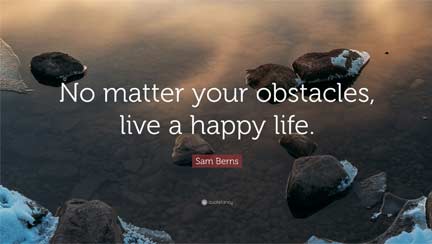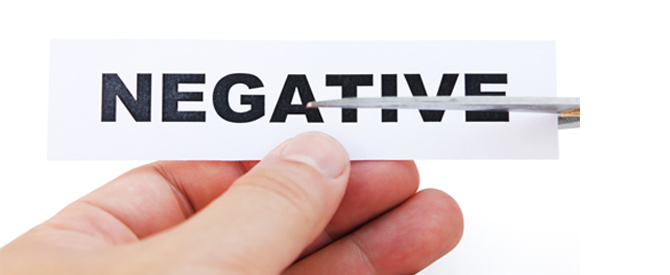When you first find yourself facing a sudden and significant life, health or relationship challenge that seems to overwhelm you, it’s normal to deny or resist it, and want it to go away.
To make sense of what is happening, you start seeking answers to questions such as: How did this happen? Why did this have to happen? Why me? What did I do to deserve this?
Many times, the answers are not easy to find. If they do come, they are hard to accept. If they don’t come, the situation is even harder to accept. In both cases, you resist it even more.
At this point, many people become anxious, fearful, angry, confused and even depressed. These emotions are destructive. They invariable affect the health of the body, which then complicates matters by adding more problems to grapple with.
If it doesn’t look like things are going to change and you have to live with the situation, you reluctantly tolerate it.
Could there be a better way?
Yes there is …
Acceptance—it is what it is
The first step to healing a persistent situation that you cannot change is accepting it. —“It is what it is,” as the popular saying goes.
In acceptance, you let go of the inner resistance and make peace with the situation. You acknowledge that things are not ideal, but you are okay with that. The mind then stops dwelling on the questions or overthinking things.
Acceptance throws off the emotional baggage and brings a sense of calm. This brings you the clarity to see things for what they really are—nothing more, nothing less.
With this newfound clarity, you can apply your mind to seek out solutions and strategies to handle the situation.
If you maintain a positive attitude, you may find the challenge that you are facing actually has some precious blessings in it.
When this happens, you have moved beyond questioning, resistance, tolerance and acceptance, and come to celebrate it in your life.
Joy happens when you graciously accept and celebrate what is.
Make the most of what you have
I came across some inspirational videos of people who positively transformed their lives not by dwelling on their challenges and what they didn’t have, but on making the most of what they did have.
Their adversities became opportunities for growth and happiness beyond what they ever imagined.
The amazing blind painter
John Bramblitt (https://bramblitt.com) lost his eyesight to epilepsy when he was in college. Filled with anger and frustration with his condition and at the world, he felt he needed an outlet for those feelings.
He remembered that during his childhood days, his mother used to paint to calm herself. And so, he started painting using his sense of touch. He discovered that colours have different textures and he has synesthesia, a condition that allows him to associate and visualize musical notes with specific colours.
As he started to paint, he no longer felt scared, angry or fearful. His mind was fully immersed “in the zone.” He found joy in the work beyond what he ever imagined. His joy is evident in the exuberant colours of his beautiful paintings.
He says that if hadn’t lost his sight, he would have never started painting. He now feels happier than he’s ever been in his life.
John Bramblitt lost his sense of sight, but found his sense of self—Truly inspirational! Watch his video below.
The courageous Sam Berns
 I try not to waste time feeling bad for myself, because when I do, there’s no room for happiness. —Sam Berns
I try not to waste time feeling bad for myself, because when I do, there’s no room for happiness. —Sam Berns
You may have heard of Sam Berns, a boy who had been diagnosed with progeria— a rare genetic disorder where a person ages prematurely and rapidly. Most people die in their teens. Sam died when he was seventeen in 2014.
In his Tedx MidAtlantic talk, My philosophy for a happy life, he said he couldn’t ignore the reality of his situation. For instance, he had difficulty breathing, couldn’t run a long distance or enjoy an intense roller coaster ride. But, he focused on things that he could do, with people whom he enjoyed.
Of course, he faltered and had bad days. Being brave didn’t mean it was going to be easy. But he stayed in a forward thinking state of mind, accepted his situation and did what he needed to do to get past it.
When asked what is the most important thing that people should know about him, he said that he wanted people to know that he lived a happy life.
To hear his Tedx MidAtlantic talk click here.
If you’re not grateful, you’re not paying attention.
There’s so much to be grateful for—we have so much and yet feel incomplete and not-enough. We get caught up in the busy-ness of life and overlook the simple things that enrich our lives everyday.
Oprah Winfrey advocates writing a gratitude journal listing five things that you are grateful for in the moment.
She rightly says: “…If you concentrate on what you have, you will always end up having more. If you focus on what you don’t have, you will never, ever, ever have enough.”
Focusing on what is not there will only make you feel incomplete, and forever needy. It will rob you of your peace of mind.
Watch her talk about gratitude here:
Life is precious and purposeful
The lives of John Bramblitt and Sam Berns are a reminder that we can rise above our limitations. Their positive mindset helped them move past the stages of questioning, resistance and tolerance and come to acceptance of their challenges. By making the best of what they had, they celebrated what life had to offer them. In doing so, their lives became an inspiration to us all.
Life is precious and purposeful. There is nothing out of order if we accept the fact that we are here to learn and grow. The lessons we learn take us closer to our true purpose of unfolding the divinity in us. The more we are able to do this, the greater will be our impact on others’ lives too.
Like this post? Sign up for the free fortnightly Spiritual Solutions Newsletter and receive the latest articles, news and updates in your email inbox!















Manisha I loved this post. It reflects how I was brought up and how I try to live my life.
Thank you Hilary. I’m so glad this article resonated with your values and upbringing.